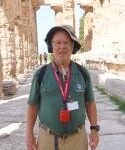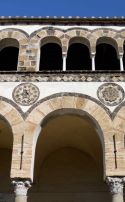A cheesy day in Salerno
August 11, 2017
We’ve moved another hundred miles up the coast to Salerno, scene of one of the major landings in World War II and one of the farthest north remnants of Manga Graciae, that set of Greek colonies that marked the Ancient Western world and defined Greek civilization around the Mediterranean.
Of course, that meant our main visit today was to the ruins of the three- 
 temple city of Paestrum (also named for Poseidon) one of the best-preserved ruins in the world. Certainly, it has wondrous Doric temples for Athena, Hera, and Poseidon (or possibly Zeus), constructed in the 5th and 6th centuries B.C. There’s also an agora and an amphitheater, where Greek democracy once flourished.
temple city of Paestrum (also named for Poseidon) one of the best-preserved ruins in the world. Certainly, it has wondrous Doric temples for Athena, Hera, and Poseidon (or possibly Zeus), constructed in the 5th and 6th centuries B.C. There’s also an agora and an amphitheater, where Greek democracy once flourished.
Another tribe replaced the Greeks in the 4th century, and in turn, the 
 Romans conquered Paestrum in 279 BC, and rearranged some of the features of the city, renaming the temples, for example. About a quarter of the old city has been excavated (one of the features I’d not seen before was the tomb of the founder of the city), with the artwork, including the striking tomb of a diver in the archeological museum.
Romans conquered Paestrum in 279 BC, and rearranged some of the features of the city, renaming the temples, for example. About a quarter of the old city has been excavated (one of the features I’d not seen before was the tomb of the founder of the city), with the artwork, including the striking tomb of a diver in the archeological museum.
The temples, rediscovered in the 18th century, as part of the “grand tour,” had also been converted to churches, naturally, but archaeologists have restored the Greco-Roman ruins on the main part of the site, which is government owned. Our guide said we should say goodbye to the Greek ruins that we’ve seen since the start of the trip. That will begin today when we visit Pompeii, smaller than Paestum, but thanks to the explosion of Vesuvius, much better preserved.
The area, Campania, is one of the main agricultural producers in the  country, and we passed many large farms along the way. We stopped at one for lunch, Tempio (temple), whose claim to fame was its production of buffalo mozzarella cheese. They gave us a tour of the 2,000 head of water buffalo, originally imported from North Africa, that produce the cheese. Lunch was cheesy, and I don’t think I’ll
country, and we passed many large farms along the way. We stopped at one for lunch, Tempio (temple), whose claim to fame was its production of buffalo mozzarella cheese. They gave us a tour of the 2,000 head of water buffalo, originally imported from North Africa, that produce the cheese. Lunch was cheesy, and I don’t think I’ll ever think of mozzarella cheese in the states as “real” cheese again. It came in kind of a bubble, with milk—but I resisted the temptation to put it in my suitcase and take it home. We had eight varieties of cheese!
ever think of mozzarella cheese in the states as “real” cheese again. It came in kind of a bubble, with milk—but I resisted the temptation to put it in my suitcase and take it home. We had eight varieties of cheese!
The other highlight was a walk from the boat to the old city. Our program director took us through what had once been palaces up on the hill (now subdivided into apartments), with clothes drying on the balconies (“you can tell who lives there”), people working out on their balconies—in short, real people doing real things. Paolo spoke to a number, and coaxed a singer to do a resounding Ave Maria.
That was in front of what purports to be (and I have no doubt is) the most  beautiful medieval church in Italy, the church of St. Matthew. It houses relics of the Apostle Matthew in a crypt in the basement. The entrance to the church has a cloister with arches that have touches of the Arab influence in the area, and if we have time, I’ll try to go back with Carolyn. It is worth a second look!
beautiful medieval church in Italy, the church of St. Matthew. It houses relics of the Apostle Matthew in a crypt in the basement. The entrance to the church has a cloister with arches that have touches of the Arab influence in the area, and if we have time, I’ll try to go back with Carolyn. It is worth a second look!
I need to get ready to go to Pompeii and say, in the local dialect, something like “yummy, yummy,” which means “let’s go.”